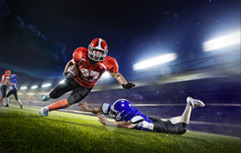
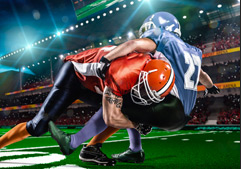
Sports Vision Training consists of the learning and training of Dynamic Visual Skills – that is “Vision in Motion”. These skills include Accommodation and Convergence, Anticipation Timing, Concentration, Depth Perception, Eye-Hand Coordination, Peripheral Awareness, Speed and Span of Recognition and Visual Reaction Speed. These are all learned skills that will improve with practice.
Football is a game that requires intense concentration and awareness of what is happening around the player. A slight deficiency or lapse in either of these areas can mean mental or physical error or much worse – injury!
The following is a comprehensive breakdown of the dynamic skills associated with each position.
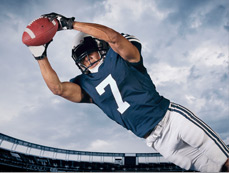
The ability of the eyes to track and constantly refocus on the ball as it approaches, so it doesn’t become a blur.
The ability to focus on the ball through a maze of outstretched arms.
Receivers must calculate exactly how far and fast the thrown ball is travelling so that they can adjust their own speed and location to be in the exact spot to catch the ball.
Football is a very fatiguing sport which requires excellent conditioning. Physical fatigue can greatly affect concentration, visual reaction time, and eye-hand coordination. Eye fatigue can also affect performance levels in much the same way. When the muscles in our eyes feel tired or strained, we feel the fatigue all over. Just like a weight lifting routine is used to increase physical endurance, visual exercises can be used to strengthen the eye muscles and thereby reduce fatigue.
A receiver must possess this skill – as he extends to make the catch, he must be sure of the location of nearby opponents. This will help to avoid injuries or allow him to make the quick move to spring into the open after making the catch.
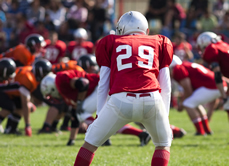
The ability of the eyes to track and constantly refocus on the ball as it approaches – and not let it become a blur.
The skill of judging the cut off point of the on-coming ball or ball carrier.
The ability to concentrate on the ball when it is in the air and make the interception. As the ball is not meant to go to the defensive back, it usually requires a great athletic effort to arrive in position to make the ‘pick’
and it is often accomplished through the distraction of waving arms and moving bodies.
This skill applies to catching (intercepting) the football as with receivers.
The ability to focus on the central object (the ball when it is in the air, the man in man to man coverage, the quarterback in zone coverage) and still be confident of the action happening around that object.
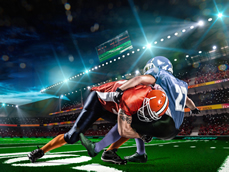
Lapses in this skill are extremely hazardous in this position as it is a high traffic area. It is also important to be able to concentrate on the ‘keys’ required to read each play with the many distractions associated with a high traffic area.
The player must be able to focus on his ‘keys’ while being aware of opponents in his area. One of the main concerns of the linebacker is the ‘crack back’ block. Early awareness and reaction to this potentially hazardous situation can greatly enhance his effectiveness and help to avoid injury.
Linebacking is a fast action/reaction position. The ability to take in visual information and instantaneously translate it into a physical reaction is vital to superior play.
Linebacking is a unique position in that the player must combine the skills of both the line and the defensive backs. Therefore he will employ the other skills not mentioned above but required specifically by the defensive backs and line.
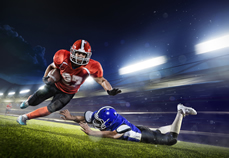
As the back handles the ball quite often in the game and can also be pass receiver, he must possess those visual skills which are acquired by the receivers such as Accommodation & Convergence, Concentration and Eye-Hand Coordination.
An important skill for the back as he must often be able to pick up blitzing linemen who have beaten their block. This skill is also required by the back while running the ball as he must be able to focus on where he is going and be able to see and recognize the action in his periphery.
Critically important to the ball carrier, as the more visual information he can take in, and the faster he can turn this into a physical reaction, the more effective his running will be.
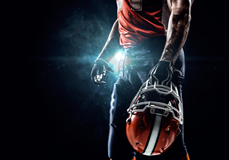
A widely used skill among quarterbacks. Exact anticipation timing can help a quarterback move out of the pocket just at the right time to avoid being sacked. It is also vital for releasing the ball on time to receivers and for completing a perfect hand-off to a running back.
The quarterback has the most extensive and difficult reads to make as the success of each play originates on his accurate read of the defensive scheme. Any laps in concentration will result in a botched play, or worse, a fumble or interception. He must also be able to concentrate downfield on his receivers through the stress and distraction of the on-coming rush.
A critical skill in that he must be able to accurately judge the distance and speed of the receiver and throw the ball to the correct point. A short coming in this area will result in incompletions or interceptions.
One of the most difficult dynamic visual skills is tracking an object that is moving away from the athlete. This is illustrated by the ability to accurately judge and complete the long pass. Quarterbacks that continuously struggle with this pass could have a deficiency in this skill.
The ability to throw a football where it should go, particularly while the quarterback is scrambling or off balance.
Also very important for the quarterback as he must be able to be aware of the rush surrounding him while concentrating on his downfield receivers. The quarterbacks who seem to step up in the pocket at the last instant to avoid a charging rusher possess this skill.
The more instantaneously he is able to process the visual information which surrounds him, the more time he will have to choose the correct reaction, and complete the play.